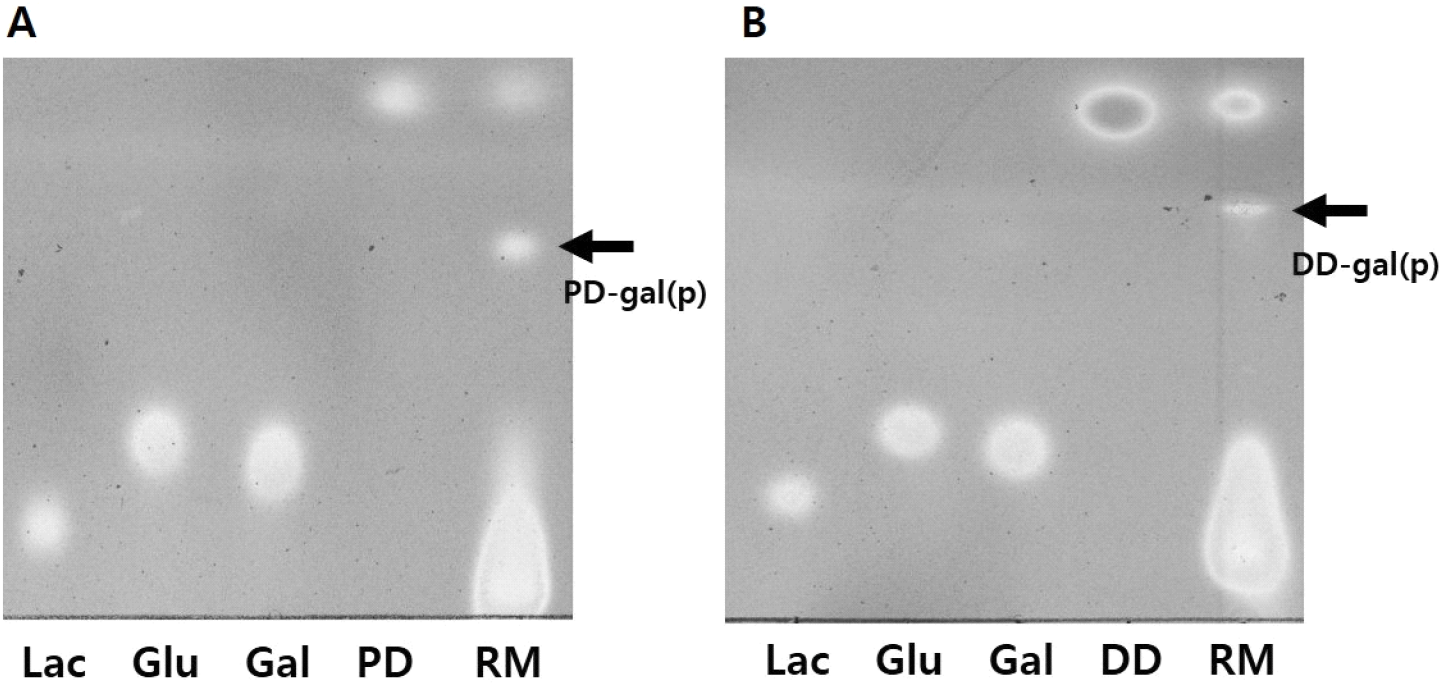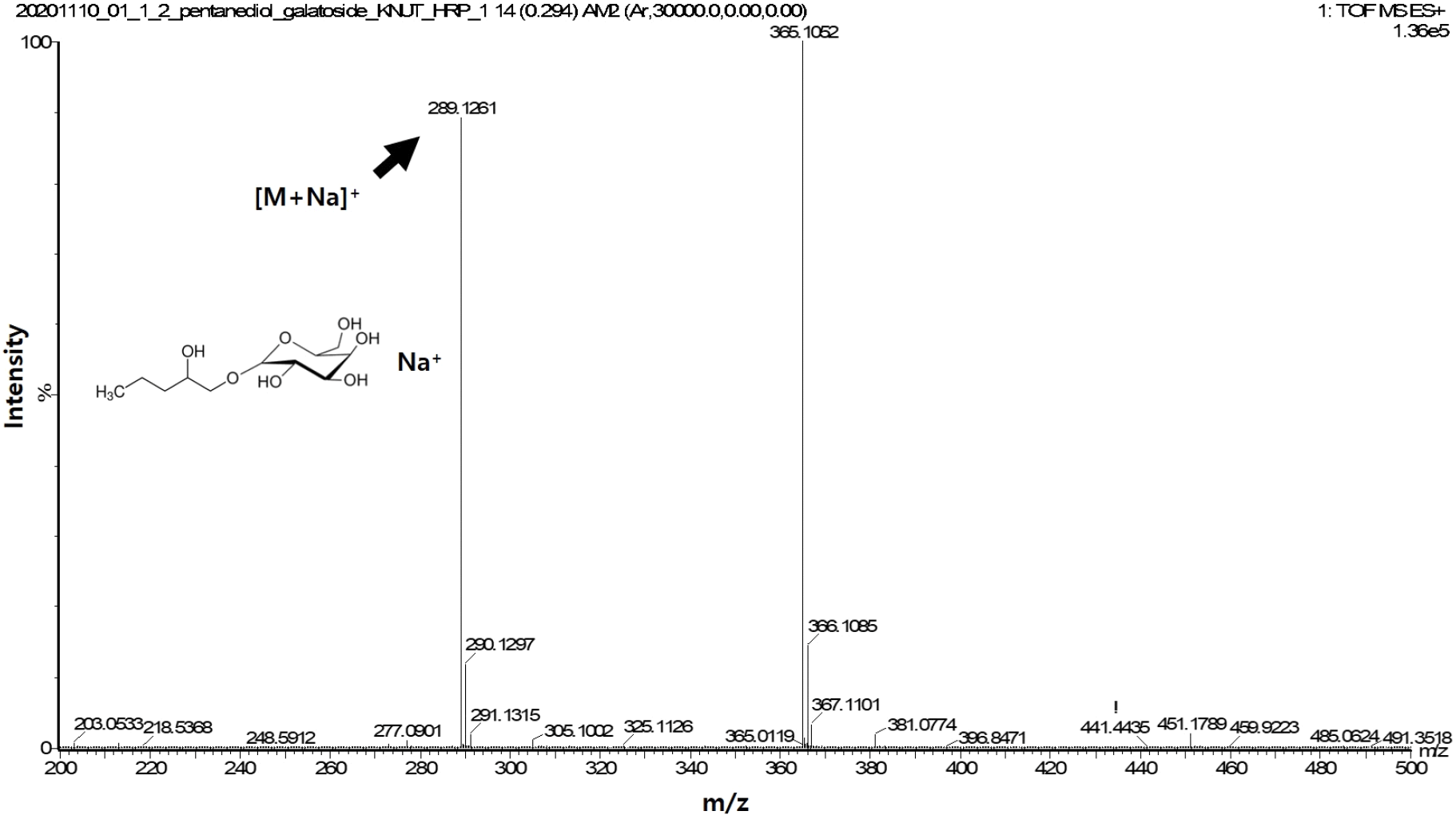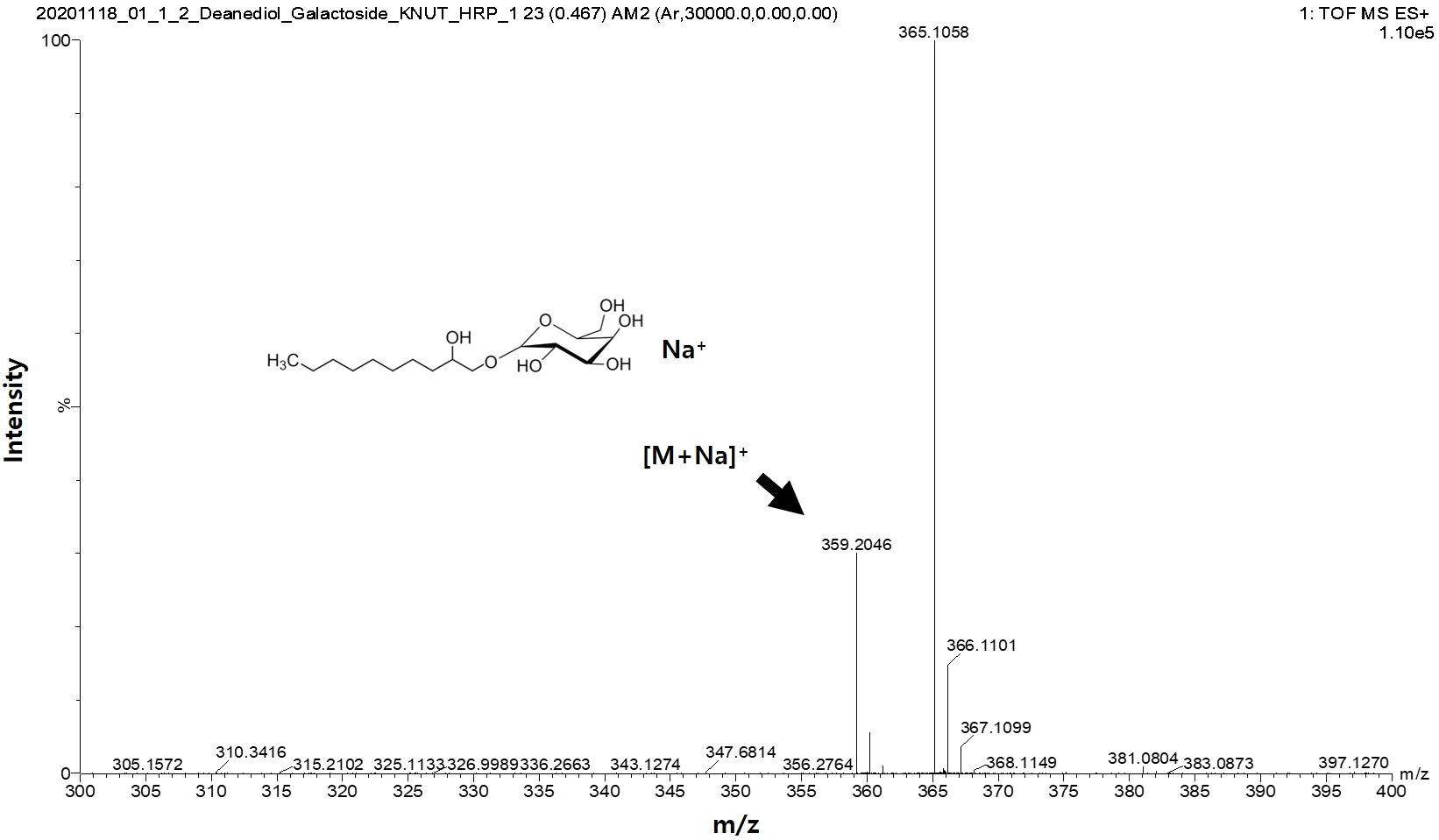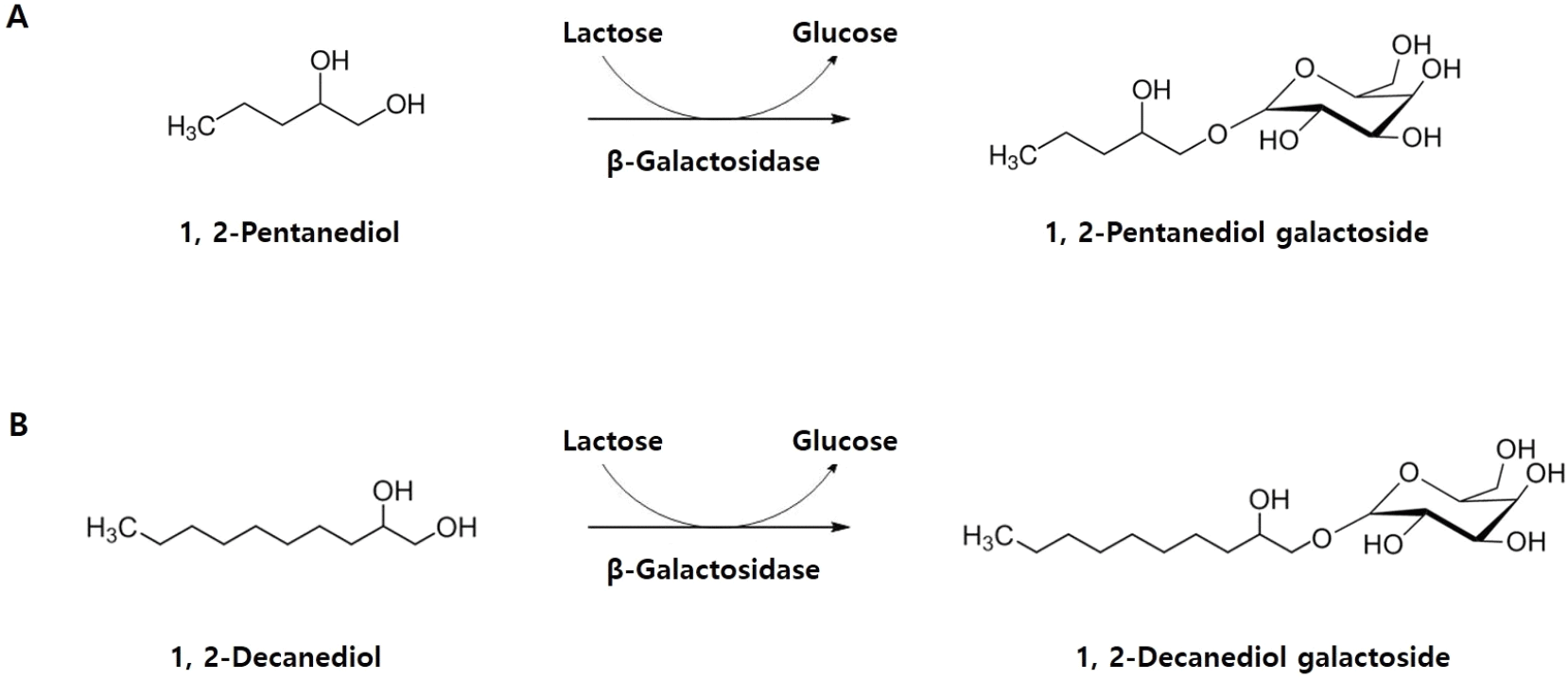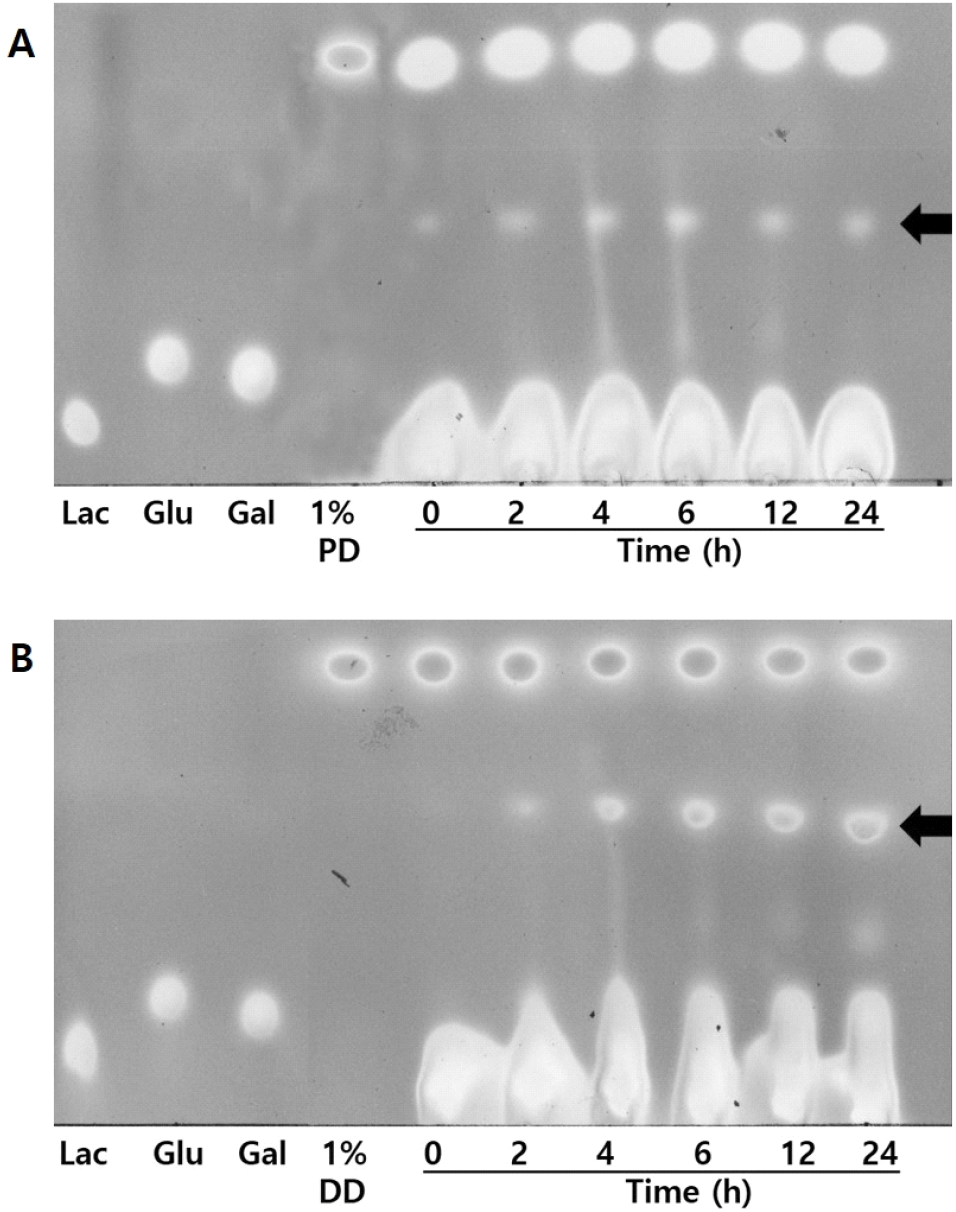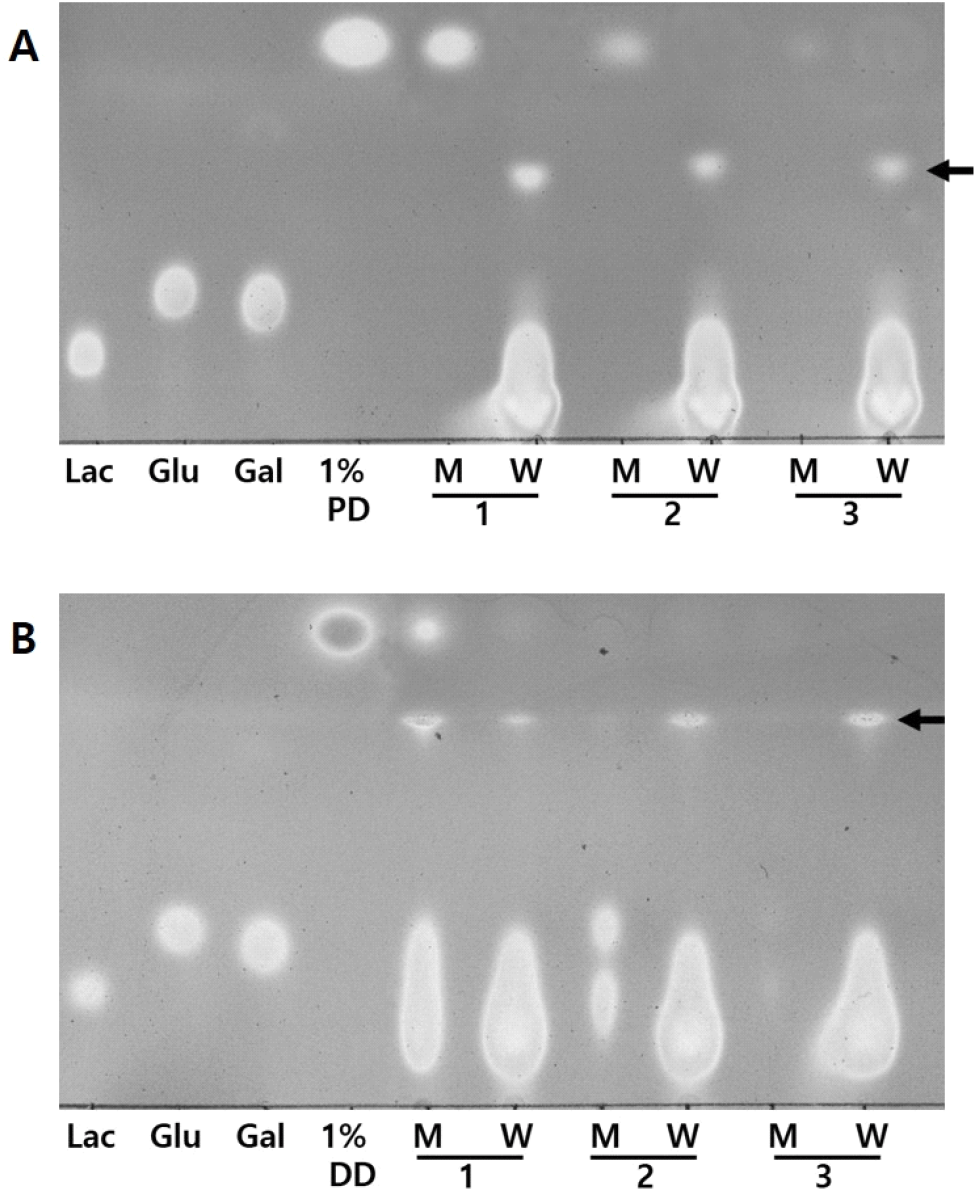Article
효소를 이용한 1,2-Pentanediol Galactoside와 1,2-Decanediol Galactoside 합성
정경환1,*
Enzymatic Syntheses of 1,2-Pentanediol Galactoside and 1,2-Decanediol Galactoside
Kyung-Hwan Jung1,*
1충청북도 증평군 대학로 61 한국교통대학교 생명공학전공 27909
1Major in Biotechnology, Korea National University of Transportation, Jeungpyung 27909, Korea
© Copyright 2022 Institute of Biotechnology and Bioindustry. This is an Open-Access article distributed under the terms of the
Creative Commons Attribution Non-Commercial License (http://creativecommons.org/licenses/by-nc/4.0/) which permits
unrestricted non-commercial use, distribution, and reproduction in any
medium, provided the original work is properly cited.
Received: Oct 24, 2022; Revised: Nov 25, 2022; Accepted: Dec 09, 2022
Published Online: Dec 31, 2022
ABSTRACT
1,2-Pentanediol (PD, C5H12O2) and 1,2-decanediol (DD, C10H22O2) can be used as ingredients in personal care and cosmetics products, where these work as antimicrobial agents. Even though those ingredients are generally recognized as safe chemicals in cosmetics, some skin problems have been often reported. To overcome this problem, we synthesized the galactoside derivatives of PD and DD, respectively, using recombinant Escherichia coli β-galactosidase. Based on our previous studies, we are expecting that those derivatives are safer alternatives to PD and DD. In each reaction mixture, sodium adduct ions of 1,2-pentanediol galactoside (PD-gal) and 1,2-decanediol galactoside (DD-gal), respectively, were identified by mass spectrometry analysis. These mass values of PD-gal and DD-gal, respectively, were in good agreement with the expected mass. In addition, throughout the fractionation experiment of the reaction mixture using methyl chloride, it was found that the addition of one molecule of galactose to PD and DD, respectively, led to an increase in their hydrophilicity. This result demonstrates that the fractionation might help increase purification yield to remove the residual PD and DD, respectively. We are hopefully expecting that through future study it will eventually be able to develop a safe cosmetic preservative.
Keywords: 1,2-pentanediol; 1,2-decanediol; β-galactosidase; transgalactosylation; Escherichia coli
Ⅰ. 서 론
현재 1,2-alkanediol은 보습력과 항균력을 가지고 있는 물질로 다양한 화장품에 첨가되어 사용되고 있다. 대표적으로 1,2-pentanediol(C5), 1,2-hexanediol(C6), 1,2-octanediol(C8), 그리고 1,2-decanediol(C10)이 있다. 1,2-alkanediol들이 비교적 안전한 물질로 화장품에 사용되지만(1), 사용 중 피부에 많은 문제를 유발한다는 보고가 계속되고 있다(2–6). 그래서, 본 연구팀에서는 지금까지 이러한 문제점 극복을 위하여 화장품에 사용되는 보습/항균 물질로 1,2-hexanediol(HD)(7–10)과 1,2-octanediol(OD)(11–13)에 대한 연구를 수행해 왔다. 이 연구에서 대장균의 β-galactosidase(β-gal)를 이용하여 HD와 OD에 galactose 한 분자를 결합시키는 transgalactosylation 반응을 수행하였다. 이 반응을 통하여 합성된 1,2-hexanediol galactoside(HD-gal)과 1,2-octanediol galactoside (OD-gal)은 상대적으로 HD와 OD에 비하여 인간 피부 각질세포(HaCaT cell)에 대한 독성이 감소되는 것으로 확인되었다(10, 12). 이는 보다 안전한 화장품용 보습/항균 물질로서 HD-gal과 OD-gal이 HD와 OD의 문제점을 극복할 수 있는 대안 물질임을 확인하는 결과라 할 수 있다.
본 논문에서는 1,2-alkanediol 중에서 화장품에 보습/항균 물질로 사용되는 1,2-pentanediol(PD, 일명 pentylene glycol, C5H12O2)와 1,2-decanediol(DD, 일명 decylene glycol, C10H22O2)의 galactoside 유도체 합성, 유도체의 mass spectrometry 분석, 그리고 유도체의 유기용매를 통한 분획에 대한 연구를 수행하였다. 이미 발표된 논문에 의하면 PD와 DD는 피부자극성 테스트(skin irritation test)에서 HD와 OD와 비교하여 매우 높은 피부 자극도를 보여주었다(6). 이 결과는 PD와 OD를 화장품에 첨가하여 사용할 때, HD와 OD보다 피부에 문제를 유발할 가능성이 더 크다는 결과일 수 있다. 그래서, PD와 DD에 대한 galactoside 유도체인 1,2-pentanediol galactoside (PD-gal)와 1,2-decanediol galactoside(DD-gal)의 합성 및 이 유도체에 대한 성능 분석이 필요하다고 생각하였다. 본 연구로 얻은 결과는 PD-gal과 DD-gal의 실용화 가능성을 확인을 위한 매우 기초적인 연구이며, 이를 기반으로 산업화를 위한 연구를 앞으로 수행할 계획이다.
Ⅱ. 재료 및 방법
1. 시약
1,2-Pentanediol과 1,2-decanediol은 Sigma-Aldrich(St. Louis, MO, USA)에서 구입하여 사용하였고, TLC(thin-layer chromatography) plate는 Macherey-Nagel(Düren, Germany)의 DC-Fertigplatten SIL G-25 UV254를 사용하였다. 나머지 본 연구에 사용한 시약들은 reagent-grade를 사용하였다.
2. β-Gal을 생산하는 재조합 대장균과 PD-gal과 DD-gal의 합성
β-Gal을 생산하는 재조합 대장균에 관한 정보는 선행연구에서 자세히 기술하였다(14). PD-gal과 DD-gal의 합성은 50 mL conical tube에서 수행하였으며, 50 mM phosphate buffer (pH 7.0)를 이용하여 conical tube에 먼저 300 g/L lactose를 녹인 후, 20 U/mL β-gal과 1.0%(w/v) PD 혹은 DD를 첨가하여 합성반응을 시작하였다. 반응은 shaking incubator(40°C, 100 rpm)에서 실시하였다.
3. 반응물에서 PD-gal과 DD-gal의 분획
초기 단계의 PD-gal과 DD-gal 정제 및 특성 확인을 위하여 9 mL methylene chloride(MC)를 이용하여 PD-gal과 DD-gal를 추출/분획하였다. 자세한 방법은 선행 논문에 자세히 기술하였으며(15, 16), 본 연구에서는 3회 추출/분획을 실시한 후, 물층과 MC층에 대한 TLC 분석을 실시하였다.
4. TLC 분석
20 × 10 cm TLC plate에 1.0 μL 시료를 loading하고 이동상(ethyl acetate : methanol : distilled water = 17 : 2 : 1(v/v))을 이용하여 전개하였다. 그리고 staining solution(1.5 g KMnO4, 10 g K2CO3, 1.25 mL 10% NaOH in 200 mL distilled water)을 TLC plate에 뿌린 후, 80°C oven에서 15분간 말려서 spot을 확인하였다.
5. Mass spectrometry 분석
질량 분석은 High Resolution ESI-Mass spectrometer(HR ESI-MS, SYNAPT G2, Waters, U.K.)를 사용하여 실시하였다. Ionization source는 ESI(electrospray ionization), analyze type은 time of flight(TOF)이며, 스펙트럼은 positive-ion mode에서 m/z(mass to charge ratio)로 확인하였다.
Ⅲ. 결과 및 고찰
1. PD-gal 및 DD-gal 합성과 mass spectrometry 분석
본 연구에서 제일 먼저 PD와 DD로부터 대장균 β-gal을 이용하여 PD-gal과 DD-gal을 합성할 수 있는지를 확인하는 실험을 수행하였다. 이미 선행연구에서 HD(C6)과 OD(C8)과 같은 1,2-alkanediol의 galactoside 유도체가 대장균 β-gal을 이용하여 합성된다는 것을 확인하였기 때문에(8, 11), 같은 조건에서 β-gal을 이용하여 PD와 DD의 galactoside 유도체 합성이 이루어지는지를 TLC 분석을 통하여 우선 확인하여 보았다(Figure 1). 반응물에 대한 TLC 분석 결과, 새롭게 합성된 spot을 확인하였고, 이를 잠정적으로 PD와 DD의 galactoside 유도체인 PD-gal과 DD-gal이 합성된 것으로 추정하였다.
Figure 1.
TLC analyses for (A) PD-gal and (B) DD-gal synthesis using β-gal, in which a 24-h sample was analyzed.
Lac, Glu, Gal, PD, and DD represent 1% standards of lactose, glucose, galactose, 1,2-pentanediol, and 1,2-decanediol, respectively. In addition, RM represents the reaction mixture. Arrow indicates a newly synthesized compound provisionally designated as PD-gal (p) and DD-gal (p), respectively.
Download Original Figure
새롭게 합성된 spot이 PD와 DD의 galactoside 유도체인 PD-gal과 DD-gal인지를 확인하기 위하여, 반응물 전체에 대한 mass spectrometry 분석을 실시하였다. 그 결과, Figure 2 및 Figure 3과 같이 sodium adduct ion 형태의 PD-gal과 DD-gal에 해당하는 mass peak[1,2-pentanediol galactoside; m/z = 289.1261(C11H22O7Na), 1,2-decanediol galactoside; m/z = 359.2046(C16H32O7Na)]를 각각 확인할 수 있었다. Mass spectrometry 분석을 통하여 관찰된 PD-gal과 DD-gal 분자에 대한 이론적인 mass(theoretical mass), mass spectrometry 분석에서 관찰된 mass(measured mass), 그리고 이 분석 결과를 통한 PD-gal과 DD-gal의 추론할 수 있는 molecular formula를 Table 1에 정리하였다.
Figure 2.
High-resolution ESI mass spectrum data of the reaction mixture of Figure 1A.
The mass spectrum was obtained in positive-ion mode. [M+Na]+ indicates sodium adduct ion of PD-gal. The preferred structure of PD-gal is shown in the mass spectrum.
Download Original Figure
Figure 3.
High-resolution ESI mass spectrum data of the reaction mixture of Figure 1B.
The mass spectrum was obtained in positive-ion mode. [M+Na]+ indicates sodium adduct ion of DD-gal. The preferred structure of DD-gal is shown in the mass spectrum.
Download Original Figure
Table 1.
Theoretical and measured masses of PD-gal and DD-gal from mass spectrometry analysis
|
|
PD-gal |
DD-gal |
|
Theoretical mass1)
|
289.28 (= 104.15 + 180.156 − 18.015 + 22.989) |
359.41 (= 174.28 + 180.156 − 18.015 + 22.989) |
|
Measured mass2)
|
289.1261 |
359.2046 |
|
Molecular formula3)
|
C11H22O7Na |
C16H32O7Na |
Download Excel Table
이와 같은 PD-gal과 OD-gal 합성에 대한 mass spectrometry 분석 결과와 선행연구인 HD-gal과 OD-gal 합성 확인을 위한 연구 결과를 근거로 하여(8, 11), 본 연구에서의 PD-gal과 DD-gal의 합성반응식을 Figure 4A와 Figure 4B와 같이 추론하였다, 선행연구에서처럼 NMR spectroscopy 분석을 통하여 PD와 DD의 −OH(hydroxyl) group에 galactose 한 분자가 결합했다는 추가적인 분석 증거가 필요하겠지만, 이미 본 연구에서와 같은 방법으로 구조적으로 유사한 1,2-alkanediol의 한 종류인 HD(C6)와 OD(C8)에서 대장균 β-gal을 이용하여 HD-gal과 OD-gal의 합성하였고(8, 11), PD와 DD 분자 구조 중에서 galactose 한 분자가 결합할 수 있는 곳이 두 개의 −OH group 밖에 없다는 사실 때문에 Figure 4A와 Figure 4B와 같은 결론에 도달하였다.
Figure 4.
(A) PD-gal and (B) DD-gal synthesis from PD using β-gal by transgalactosylation reaction.
Download Original Figure
2. 반응 시간에 따른 PD-gal 및 DD-gal 합성과 반응물의 methylene chloride를 이용한 분획
합성반응 시작 후, 시간이 지나면서 PD-gal과 DD-gal이 PD와 DD로부터 합성되는 과정을 TLC 분석을 통하여 관찰하였다(Figure 5). 선행 연구에서와 같이 24시간 정도가 지나가면 어느 정도 합성이 완료되는 현상을 관찰하였다(7, 13). 선행연구에서 1,2-alkanediol galactoside의 정제와 특성 분석을 위한 실험으로 water-immiscible solvent를 이용한 분획 실험을 실시하였다(13, 15). 본 연구에서도 같은 이유로 반응물에 대한 분획을 MC를 이용하여 3회 연속적으로 수행하였다. 그 결과, Figure 6에서 관찰되는 것과 같이 물 층으로 PD-gal과 DD-gal이 모이고, MC 층으로 반응하고 남은 잔여 PD와 DD가 각각 분획되는 것을 관찰할 수 있었다. 이러한 MC를 이용한 분획 방법을 PD-gal이나 DD-gal의 정제에 적용하면, 잔여 PD나 DD가 어느 정도 제거되기 때문에 PD-gal이나 DD-gal의 정제 수율을 증가시킬 수 있을 것으로 생각되어진다. 또한, PD-gal과 DD-gal이 물 층으로 분획되는 현상은 galactose 한 분자가 결합되어 PD나 DD 분자에 부족한 친수성 성질이 증가되어 나타나는 현상으로 PD와 DD에 galactose가 결합했다는 간접적인 증거이기도 하다. 이러한 현상은 다른 1,2-alkanediol galactoside에서도 관찰되었으며, 이를 이용하여 효율적인 galactoside 유도체 정제를 수행하였다(13, 15).
Figure 5.
Time courses of (A) PD-gal and (B) DD-gal synthesis using β-gal during 24 hr.
Lac, Glu, Gal, and PD represent 1% standards of lactose, glucose, galactose, 1,2-pentanediol, and 1,2-decanediol, respectively. Arrow indicates the synthesized PD-gal and DD-gal, respectively.
Download Original Figure
Figure 6.
TLC analyses after the extraction of a reaction mixture from (A) PD-gal and (B) DD-gal synthesis reaction using methylene chloride, in which a reaction mixture was collected at 24 hr.
M indicates the methylene chloride phases after the reaction mixture extraction. W indicates the water phase after extraction. Numbers 1, 2, and 3 represent the first, second, and third extraction, respectively, using methylene chloride. Lac, Glu, Gal, PD, and DD represent 1% standards of lactose, glucose, galactose, 1,2-pentanediol, and 1,2-decanediol, respectively. Arrow indicates the PD-gal and DD-gal, respectively.
Download Original Figure
Ⅳ. 결 론
대장균 β-gal을 이용하여 PD와 DD로부터 PD-gal과 DD-gal을 합성하는 실험을 수행하였다. Mass spectrometry을 통하여 합성 반응물에서 sodium adduct ion 형태의 PD-gal과 DD-gal에 해당하는 mass peak를 각각 확인할 수 있었다. 다른 1,2-alkanediol의 galactoside 유도체 합성 결과를 근거로 PD-gal과 DD-gal이 합성되는 반응식을 추론하였으며, MC를 이용한 반응물 분획 실험에서 galactose 분자의 결합으로 PD-gal과 DD-gal의 친수성이 증가하는 현상을 관찰하였다. 이러한 분획 실험 결과는 galactose의 결합을 입증하는 결과이며, PD-gal이나 DD-gal의 정제 효율성을 증가시키는데 이용될 수 있을 것으로 생각된다. 그러나, 아직까지 PD-gal과 DD-gal은 합성 선례가 없는 새로운 합성물질이기 때문에 기능성 소재로서 추가적인 심층 연구가 더 필요할 것으로 생각된다. 하지만, 본 연구에서 얻은 연구 결과는 인간 피부에 안전한 화장품 소재로서 PD-gal과 DD-gal의 산업화를 위한 기초 연구자료로 사용될 것으로 기대하고 있다.
사사
이 논문은 2022년도 한국교통대학교 지원을 받아 수행하였습니다.
참고문헌
Kim YO, Jung KH. (2016) Enzymatic synthesis of 1,2-hexandiol galactoside by whole cells of β-galactosidase-containing recombinant
Escherichia coli. J Life Sci. 26, 608~13.


Kim YO, Lee HY, Jung KH. (2016) NMR spectroscopy and mass spectrometry of 1,2-hexanediol galactoside synthesized using
Escherichia coli β-galactosidase. J Kor Oil Chem Soc. 33, 286~92.


Kim YO, Jung KH. (2017) Water-holding capacity and antimicrobial activity of 1,2-hexanediol galactoside synthesized by β-galactosidase. J Soc Cosmet Sci Korea. 43, 373~9.

Kim JS, Jung KH. (2018) Cytotoxic effects of 1,2-hexanediol and 1,2-hexanediol galactoside on HaCaT. J Soc Cosmet Sci Korea. 44, 343~7.

Lee HY, Jin HJ, An SH, Lee HW, Jung KH. (2021) Confirmation of enzymatic synthesis of 1,2-octanediol galactoside using mass spectrometry and NMR spectroscopy. J Kor Appl Sci Technol. 38, 824~31.

Kim JS, Jin HJ, Jung KH. (2021) Comparative study of antimicrobial and cytotoxic effects of 1,2-octanediol and 1,2-octanediol galactoside. J Kor Appl Sci Technol. 38, 629~37.

Jung KH. (2022) The study of optimal conditions for synthesis and purification of 1,2-octanediol galactoside. J Kor Appl Sci Technol. 39, 1~9.

Jung KH. (2008) Enhanced enzyme activities of inclusion bodies of recombinant β-galactosidase
via the addition of inducer analog after L-arabinose induction in the
araBAD promoter system of
Escherichia coli. J Microbiol Biotechnol. 18, 434~42.

Kim YO, Jung KH. (2016) β-Galactosidase-catalyzed synthesis of 1,2-hexanediol galactoside and its purification using ethyl acetate extraction followed by silica gel chromatography. J Kor Oil Chem Soc. 3, 498~506.


Jung KH. (2017) Purifications of phenoxyethanol galactoside and chlorphenesin galactoside using solvent extraction followed by gel chromatography. J Oil Appl Sci 34, 954~61.

